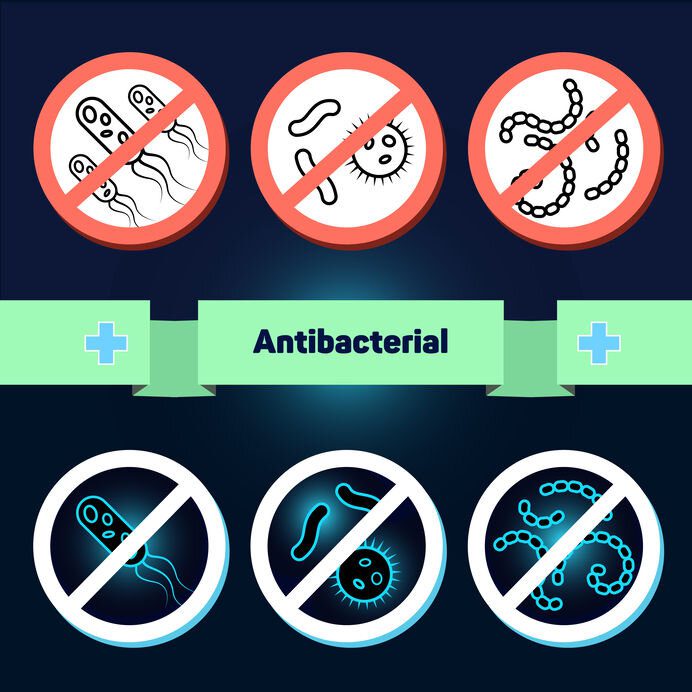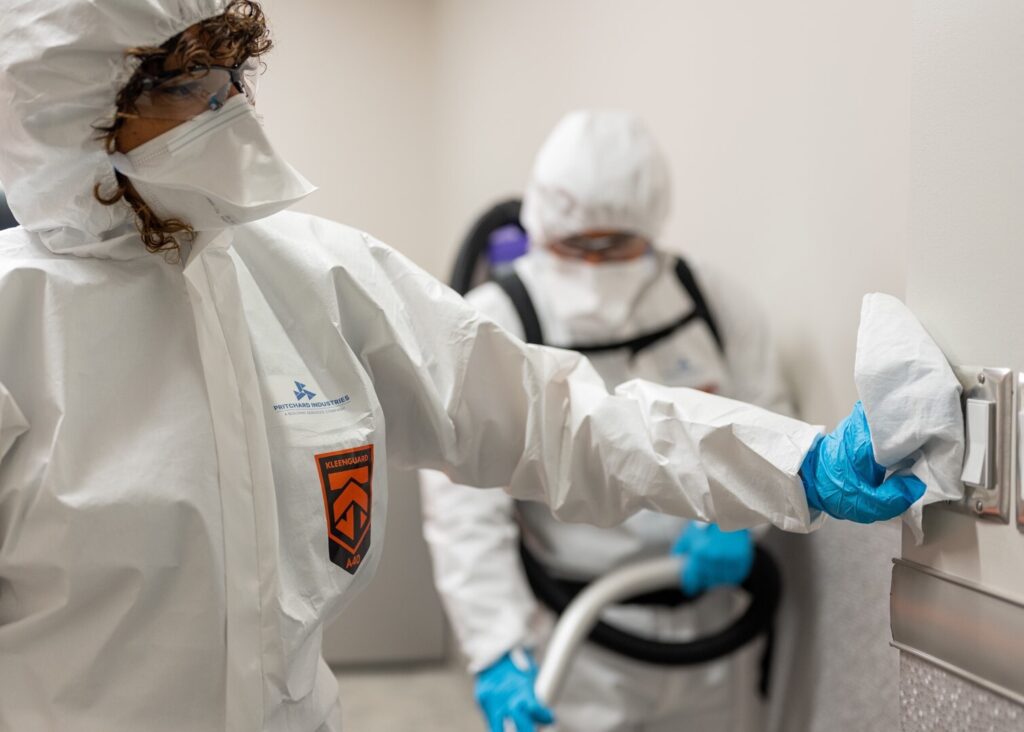What is an Antimicrobial Coating? The Complete Guide

Demand for antimicrobial coating technology has skyrocketed in recent years. By 2032, the value of this market is expected to grow by an incredible 12.80%.
Global events, such as the COVID-19 pandemic, combined with stricter regulatory standards for health and safety throughout organizations, have highlighted the potential of antimicrobial solutions.
In all industries, today’s business leaders know preserving a clean, hygienic, and safe environment is crucial not only to protect customers, but also to ensure employee productivity, protect their reputation, and minimize the risk of fines. Fortunately, in the fight against pathogens, bacteria, and germs, antimicrobial coatings represent an incredible opportunity.
Offering companies an opportunity to proactively protect surfaces and environments, antimicrobial coatings give organizations the power to effectively defend their reputation, customers, and teams.
What is an Antimicrobial Coating?
An antimicrobial surface coating is a chemical agent that prevents the growth of dangerous microbes. Unlike an antibacterial coating, which specifically focuses on minimizing the growth of harmful bacteria, antimicrobial coatings have a broader scope. They can protect surfaces against the development of everything from viruses to fungi.
Antimicrobial coatings take disinfection and facility maintenance to a new level. They contain special additives that prevent the growth of mildew, mold, and bacteria in their tracks. While traditional solutions for disinfection provide temporary relief from microbes, antimicrobial coatings create a lasting shield. This makes them a game-changing solution for maintaining hygienic environments.
Antimicrobial coatings can form a comprehensive part of a continuous defense mechanism for any business. They’re commonly used to protect high-touch surfaces (often exposed to large numbers of potentially dangerous microbes), medical devices, and equipment.
Notably, an antimicrobial surface coating is also versatile enough to deliver exceptional benefits in virtually any landscape, from schools and healthcare facilities to pharmaceutical labs.
Leveraging advanced technologies, these coatings release antimicrobial agents that disrupt the cellular functions of microbes upon impact. They’ve grown increasingly valuable in recent years as a result of ever-advancing disease threats throughout the world and ongoing health and safety challenges.
The Benefits of Using Antimicrobial Coatings
An effective antimicrobial coating is a powerful barrier against the countless threats caused by various microbes and microorganisms. Used effectively, these coatings deliver:
- Enhanced disinfection: Compared to conventional cleaning methods, antimicrobial coatings deliver a heightened level of protection against bacteria, viruses, and fungi. The coated surface consistently inhibits antimicrobial activity and bacterial growth, creating a more hygienic and safe environment for all users.
- Long-lasting protection: One of the standout benefits of an antimicrobial coating is its ability to offer long-lasting protection. While most cleaning methods are reactive, providing temporary relief until the next cleaning session, antimicrobial coatings are proactive. They create a shield that continues to drive results for extended periods.
- Surface protection and durability: Microbes can cause damage to the existing surfaces throughout your organization, increasing the risk of bacterial growth. Antimicrobial coatings form a resilient barrier that safeguards against additional wear and tear and maintains the structural integrity of essential surfaces.
- Reduced spread of infectious diseases: The right antimicrobial coating doesn’t just reduce the spread of viruses and diseases in medical settings. It also ensures pathogens can’t spread in virtually any other environment. They play a role in helping to break the chain of infection, protecting both consumers and staff.
- Versatility: Antimicrobial coatings are a versatile solution, suitable for a variety of environments, surfaces, and materials. A disinfection service provider can ensure you access the correct coatings for your specialist equipment and unique environments.
Common Active Ingredients in Antimicrobial Technology
Antimicrobial coatings are often defined by their use of unique active ingredients, which allow them to disrupt the cellular structure of microbes upon impact. At Pritchard, we use coatings which feature a variety of different active ingredients, such as:
- Silver ions: Silver ions have potent antimicrobial properties, capable of targeting viruses, fungi, and bacteria. They demonstrate broad spread effectiveness against all kinds of microbes and are known for their durability and long-lasting protection. However, they can sometimes cause discoloration over time. Silver ions are best used for surfaces with high human contact, such as medical equipment and textiles.
- Copper compounds: Exceptional for disrupting microbial cell membranes and cellular functions, copper compounds provide continuous protection against microbial activity. However, like silver, they can tarnish over time and may eventually corrode. Copper compounds are popular in healthcare settings, where ongoing protection is crucial to eliminate the spread of disease.
- Quaternary Ammonium Compounds: QACs are effective at disrupting microbial membranes and preventing ongoing growth. They’re extremely versatile and can be used in a range of coating formulations to offer effective protection against multiple microorganisms. However, microbes can sometimes become resistant to these coatings over time. QACs are best used in public spaces where versatility is crucial.
- Triclosan: Known for its ability to interfere with microbial lipid synthesis, triclosan has a long history of efficacy and broad-spectrum success. However, some have expressed concerns about the impact it may have on the environment. In most cases, Triclosan is used in personal care products, where historical success is valuable.
- Zinc Pyrithione: Promising long-lasting effectiveness against various microorganisms, this broad-spectrum solution is highly stable and robust. However, it can create toxicity concerns in higher concentrations. Often, this active ingredient is used for coatings on surfaces prone to algae or fungal growth, such as outdoor furniture.

Applications Across Industries
Like many cleaning services and solutions, antimicrobial coatings have a positive impact across various industries and environments. Any environment that can benefit from ongoing surface protection can take advantage of an antimicrobial coating.
However, there are some industries where these solutions are particularly valuable, such as:
Healthcare
Microbial growth can be extremely dangerous in healthcare facilities. Surfaces in clinics, hospitals, and medical facilities are regularly exposed to various kinds of pathogens. An antimicrobial coating can provide a crucial level of protection against these substances.
The right solution can provide an added layer of protection, inhibiting the development and spread of bacteria and viruses and reducing healthcare associated infection. This safeguards patients and healthcare employees while also ensuring facilities can adhere to strong quality control and compliance standards.
The Food Industry
In the food industry, antimicrobial coatings are frequently used in processing facilities to maintain product safety and hygiene standards.
These substances contribute to the safety of consumers and workers by preventing the growth of harmful substances on equipment, surfaces, and packaging materials. They can also help food companies to defend their reputation in a competitive environment.
Public Spaces
Public spaces with high levels of traffic, such as airport terminals, entertainment venues, and public transportation centers, often face unique challenges when it comes to preserving safety and hygiene. Antimicrobial coatings offer a solution to mitigate the threats in these areas.
Coated surfaces, such as seating, handrails, and other touchpoints, can provide a continuous defense against the spread of pathogens. The right solutions help to improve, protect, and preserve public safety and well-being.
How Antimicrobial Coatings Are Used
Applying antimicrobial protection to any surface requires careful preparation and expertise. Pritchard is experienced in delivering exceptional disinfection services and follows a careful process to ensure the right results. This process often involves:
- Surface preparation: Before an antimicrobial coating is applied, a contaminated surface needs to be thoroughly disinfected and prepared. Cleaning and drying the surface carefully will ensure the coating can bond to the surface effectively.
- Choosing a coating: Next, an antimicrobial specialist will select the appropriate coating for the situation. They’ll examine factors like surface material compatibility, intended use environment, and specific microbial threats. They will also account for the ease of use of the coating and the duration of protection it can offer.
- Following application instructions: Following clear instructions provided by a surface coating manufacturer, the coating can then be applied to the surface. A professional will cautiously follow health and safety guidelines, and adhere to the recommended methods suggested by the manufacturer, ensuring even coverage and avoiding over-application.
- Drying: Following application, many antimicrobial coatings need adequate time to dry and cure. During this time, it’s important to ensure the coating isn’t disrupted or contaminated by any other substances.
- Inspection: Finally, an expert will inspect the coating and ensure that it clearly covers the entire surface. They’ll touch up any gaps and address any issues that may have occurred during the drying and curing stage.
Pritchard's Next-Level Disinfection Services
While applying an antimicrobial coating to a surface may seem simple enough, the process can be complex. Improper application means your surface doesn’t benefit from the full protection the coating can offer. This is why it’s so important to consider accessing professional assistance.
An expert cleaning or disinfection team will be able to help you choose the right antimicrobial coating for your situation, prepare surfaces thoroughly, and apply coatings safely. They’ll ensure the surface is fully coated and prevent you from using methods or solutions that might damage your surface.
Applying an antimicrobial coating to crucial surfaces, materials, and devices throughout your organization can provide an extra layer of protection against increasingly dangerous microbes and viruses. However, the right application requires the right level of expertise.
At Pritchard, we have years of experience delivering advanced cleaning solutions to companies from every industry. Our local teams act as a crucial source of support and guidance to businesses elevating their strategy in the fight against germs, disease, and contamination.
With a focus on innovation, we constantly train our technicians in the latest cleaning and disinfection techniques, and embrace cutting-edge solutions for our clients. We can select and apply the ideal antimicrobial coating for your specific business needs. What’s more, we’re committed to staying ahead of the curve with constant investment in new solutions and technology.
Reach out to Pritchard today to find out how we can tailor our disinfection and cleaning services to the needs of your company and industry. Contact us here, and discover the benefits of antimicrobial coatings for yourself.

